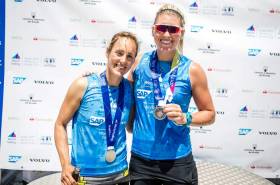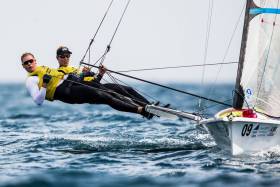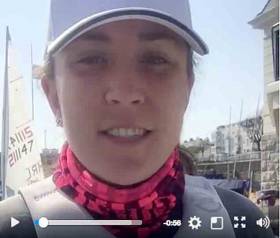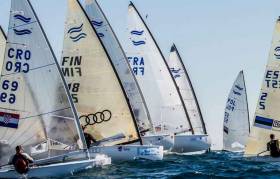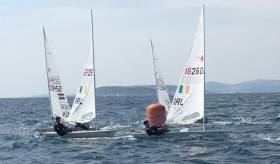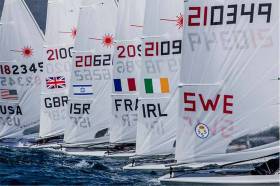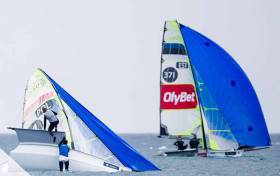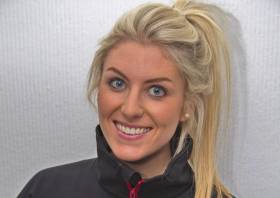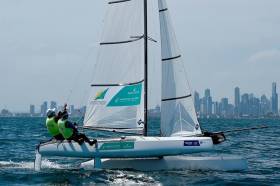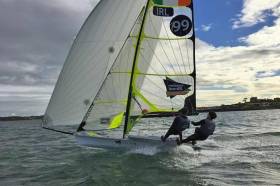Displaying items by tag: Tokyo 2020
Royal Irish 49erFx Crew Saskia Tidey Sails to Silver Medal at World Sailing Cup Finals
Dun Laoghaire sailor Saskia Tidey from the Royal Irish Yacht Club on Dublin Bay, now sailing for Team GB, won a World Sailing Silver Medal yesterday in Santander, strengthening her 2020 quest for the Tokyo Sailing Olympics with new partner Charlotte Dobson.
Martine Grael and Kahena Kunze (BRA) continued their dominance in the 49erFX, adding the World Cup Series title to their list of honours. The Brazilians had commented earlier in the week that they had found the going tough. But like true champions they dug deep and managed to churn out a gold medal winning performance.
They entered the Medal Race three points ahead of Charlotte Dobson and Saskia Tidey (GBR). A fourth place for the Brazilians and a sixth for the Brits ensured it was Brazilian gold with British silver. Lili Sebesi and Albane Dubois (FRA) conclude the podium.
Watch a replay of the medal races in Santander here
Medal Race Place Confirmed for Saskia Tidey at World Cup Final, Royal Irish Sailor Lies Second in 49erFX
Friday's action at Sailing's 2017 World Cup Series Final in Santander, Spain saw the Medal Race places decided in six of the 11 events.
The Men's and Women's Skiff, Windsurfers, Mixed Multihull and Foiling Formula Kiteboarding all concluded their fleet racing and the top ten racers will now advance to Saturday's live Medal Races to fight to become the World Cup Final Champion in their respective fleets.
Brazil's Patrcia Freitas has opened up a 20 point advantage over the chasing pack and only a disqualification on the final day will see her lose gold. Fernando Echávarri and Tara Pacheco (ESP) have a firm hold in the Nacra 17 whilst the Men's and Women's Skiff fleets will see final day duels for the titles.
Friday's conditions served up exceptional conditions for the 260 sailors from 41 nations with a steady north east breeze in the region of 12-14 knots.
The Men's and Women's Skiff Medal Races will see some close-knit battles with minimal separation between the leading competitors.
James Peters and Fynn Sterritt (GBR) lead Poland's Lukasz Przybybtek and Pawel Kolodzinski by a single point in the 49er. Dylan Fletcher and Stu Bithell (GBR) are knocking on the door in third.
Three races played out for the 16-boat 49er fleet and the leading trio did enough to hold firm in the medal positions. Local favourites Diego Botin and Iago Lopez (ESP) are eight points off the podium places.
Rio 2016 Olympic gold medallists Martine Grael and Kahena Kunze (BRA) and Great Britain's Charlotte Dobson and Saskia Tidey of the Royal Irish Yacht Club in Dun Laoghaire have been fighting hard all week in the 49erFX. When you think the initiative swings one way, a counter attack ensures somewhat of a level playing field.
Grael and Kunze were able to extend their overnight single point lead to three after a steady trio of results. "It was quite a tricky day because it was so shifty to the right of course,” said Kunze, "So people who had a good start from port did really well. We struggled a little in the second race.”
Grael added, "We found it difficult to cross because there were a few boats ahead of us.”
By their own admission, the Brazilians have had somewhat of a mixed week in Santander but a lead is a lead and they're excited for the final showdown, "At the end of the day, with all the ups and downs we still opened three points so we are feeling confident ahead of tomorrow.”
The biggest smile of the day in the boat park was reserved for Brazil's Patricia Freitas who won all three races in the Women's Windsurfer, RS:X. The Brazilian managed to open up a 20-point lead over China's Yunxiu Lu, who is guarantted at least bronze, and needs to stay out of trouble in the Medal Race to confirm gold.
"It was an exceptional day,” said Freitas through a beaming smile. "We had amazing sailing conditions today, we had light winds at first but it picked up fast. Above all, I had good speed and I was happy about that.”
Stefanie Elfutina (RUS) completes the podium ahead of the Medal Race with Majia Zheng (CHN) following.
Kiran Badloe (NED) matched Freitas' perfect day with one of his own. A trio of race wins hands him a 16-point advantage over Louis Giard (FRA) who in turn is eight points clear of Shahar Zubari (ISR).
In the Mixed Multihull, Nacra 17, Fernando Echávarri and Tara Pacheco (ESP) moved 18 points clear and without any major dramas, should seal gold on Saturday. John Gimson and Anna Burnet (GBR), Tom Phipps and Nicola Boniface (GBR) and Italy's Ruggero Tita and Caterina Marianna Banti are split by six points and will go for the two remaining podium places.
France's Nico Parlier has almost wrapped up gold in the Foiling Formula Kiteboarding. He is 27 points clear of Guy Bridge (GBR). Only a disaster from tomorrow's Medal Race Series – three single point races – will see Parlier lose his grasp on the gold medal.
Defending World Cup Series Final Champion Oliver Bridge occupies third overall.
The Men's and Women's Dinghies entered a critical point of the week with just two fleet races remaining on Saturday.
Panagiotis Mantis and Pavlos Kagialis (GRE) maintained their lead in the Men's Two Person Dinghy, 470. Stu McNay and Dave Hughes (USA) managed to post a 2-4 to advance to second, eight points off the leaders.
In the Women's 470, Rio 2016 Olympic gold medallist Hannah Mills, sailing with Eilidh McIntyre (GBR), were solid once again posting a 2-1. The British pair are eight points clear of Afrodite Zegers and Anneloes van Veen (NED).
The ongoing battle between Jean Baptiste Bernaz (FRA), Charlie Buckingham (USA) and Philipp Buhl (GER) continued today in the Laser, Men's One Person Dinghy, with minimal separation once again between the trio. Bernaz leads on 31 points and Buckingham and Buhl followed on 35 and 37.
Evi van Acker (BEL) managed to extend her lead over Anne-Marie Rindom (DEN) in the Women's One Person Dinghy, Laser Radial. Van Acker posted a 1-7 compared to Rindom's 4-11 and is now ten points clear.
Hungary's Zsombor Berecz shone above the pack in the Men's Heavyweight One Person Dinghy, recording a 2-1 to move into second place and within two points of leader Ben Cornish (GBR). Ed Wright's 8-8 sees him third overall.
Medal Races are due to commence at the earlier time of 11:00 on Saturday 10 June.
Annalise Murphy Fitness: A Typical Day Video
As Annalise Murphy prepares her campaign for Gold at Tokyo 2020, the National Yacht Club Olympic Silver Medalist has shared a 'day in her life video' training around Dublin Bay.
Three hours on the water with boat handling, speed testing and race practice and video analysis, she follows it with a 63–km endurance bike ride in the afternoon. See video below.
A 28 and a 32 scored at the 53–boat Finn 2017 European Open Championships leave Ireland's Oisin McClleland from Donaghdee Sailing Club in 29th overall. The Northern Ireland solo sailor is competing at the Yachting Club de la Pointe Rouge, Marseille, France. The competition includes an Under–23 division.
Ed Wright from Great Britain opened the 2017 Championship with two emphatic race wins after a strong mistral kept the fleet on shore for most of the day. France's Jonathan Lobert was consistent with two fourth places to sit in second, while two fifth places for Anders Pedersen of Norway leaves him in third overnight.
After the practice race was abandoned yesterday, the mistral was still in place for the first full day of racing and though the early indication was that racing would start on time, this was soon rethought as gusts of 37 knots and a very steep sea was recorded on the race area. So the fleet sat on shore under AP under mid afternoon, when finally the wild wind abated slightly, but enough to get some racing underway, though the wind was still topping out at 30 knots.
Each race started with one general recall and then the black flag. The race was really one of two halves: in the starting area big waves and 25 knot winds; at the top mark, 10 knots, flat water and 60 degree shifts, with the windward mark set a few hundred metres of the high ground of L'ile de Pomegues.
The first race was initially led by class veteran Rob McMillan, now of Australia, who had a 30 second lead round the top mark. However his training partner, Wright, had taken the lead on the second upwind to extend down the reaches for his first win of the day, followed by Hungarian Zsombor Berecz and Ben Cornish of Great Britain.
The second race was much the same with the strong winds at the start line giving way to huge random shifts the further the fleet progressed up the course. This time Wright led all the way round, to win from Sweden's Max Salminen and the young Nenad Bugarin from Croatia.
The fleet finally came ashore after 19.00, exhausted, but happy after an awesome day of Finn sailing.
Racing in the opening series continues until Saturday, with the Semi-final and Final scheduled for Saturday afternoon.
Top ten after two races
1. Edward Wright, GBR, 2
2. Jonathan Lobert, FRA, 8
3. Anders Pedersen, NOR, 10
4. Max Salminen, SWE, 11
5. Ben Cornish, GBR, 11
6. Zsombor Berecz, HUN, 12
7. Milan Vujasinovic, CRO, 17
8. Oliver Tweddell, AUS, 19
9. Ioannis Mitakis, GRE, 21
10. Henry Wetherell, GBR, 21
Irish Olympic sailor Finn Lynch enters the Sailing World Cup in Hyères this morning writes Nathaniel Ogden.
The World Cup is considered a vital piece of preparation for the Olympic Games, towards which Finn is hoping to continue his Tokyo 2020 campaign.
The youngest ever sailor to represent Ireland at Olympic level, he currently holds a world ranking of 66 in the men’s Laser class. Although slightly below his personal high of 59th position in January of this year, Finn has seen an exceptional rise through the ranks of the Laser fleet during his short adult career, training under the renowned Croatian coach, Jozo Jakelic.
This is his first time competing in Hyères, on the Côte d'Azur, although he is no stranger to the European circuit. Earlier this month he finished in seventh place in the Split Olympic Sailing Week, up from his eighth place position at the same event last year.
Finn will be joined in Hyères this week by fellow Irish sailors Aoife Hopkins and Aisling Keller of the women’s Laser Radial fleet, and Jade O’Connor from the IKA Formula Kite fleet.
The only French meeting of the circuit, Hyeres was awarded the prestigious Sailing World Cup label in 2013 by World Sailing, and it is now an integral part of the Cup.
Running from the 23rd - 30th April the 10-day long The Sailing World Cup - Hyères TPM brings together the finest international dinghy competitors to make it France’s largest sailing event, both in terms of its number of participants and international recognition.
The Sailing World Cup is a flagship event attended by all the greatest athletes in men’s and women’s Laser, Laser Radial, 470, 49er, Finn, IKA, Nacra 17 and RS:X classes, as well as the 2.4 metre disabled class. This year 541 sailors in 406 boats will be representing 52 nations across all classes.
Finn says he’s anticipating some sun and plenty of hiking during the regatta, we wish him and all the other Irish entrants the best of luck in the coming days!
Liam Glynn Posts Solid Laser Results But Tough Day For Irish 49ers at Trofeo Princesa Sofía
In the Laser class, Liam Glynn from Ballyholme YC lies a creditable 33rd from 134 after four races at the 48th edition of the Trofeo Princesa Sofía regatta in Palma today. The former Topper World Champion took a 3 and a 7 in today's qualifying rounds.
646 boats and 833 sailors from 53 different nations are competing on the Spanish island.
A 'did not finish' result in the sixth qualifying race has dropped last year's winner Ryan Seaton 14 places from 13th to 27th overall in the 49er class. Now sailing with new crew Seafra Guilfoyle from Royal Cork, the Carrickfergus Sailing Club ace also scored a sixth and a 15th today in the 59–boat fleet.
From a funky first day of racing when the promising solid morning breeze evaporated to become difficult, shifty and unsettled and then disappeared, it was a return to business as usual for the second day of competition at the
The Bay of Palma was blessed by the reliable light Embat sea breeze which filled in on cue to keep the 10 classes racing on, or close to schedule.
Howth Yacht Club's Robert Dickson and Sean Waddilove are 48th overall. Wet Dreams sailed by Mark Hassett and Oisin O'Driscoll from West Cork stay 39th. Seán and Tadhg Donnelly from the National Yacht Club move up one to 42nd.
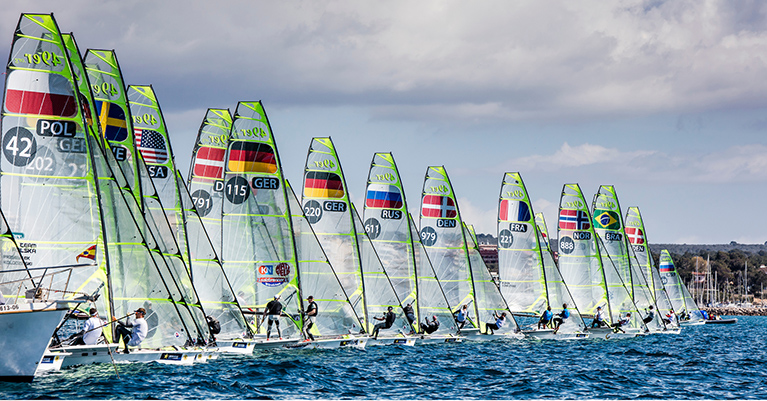 49ers line up for a start today in Mallorca. Photo: Jesus Renedo
49ers line up for a start today in Mallorca. Photo: Jesus Renedo
Spain’s 49er duo who finished ninth in Rio 2016, Diego Botin and Iago Lopez Marra continue to lead the Men’s Skiff class winning two of their qualifying fleet races, and so lie five points ahead of the GBR duo James Peters and Fynn Sterritt.
Botin commented: “It’s been a really solid day for us even it is was a bit complicated. Our goal is to be on top at the end of the championship. We’ve only sailed two days and we haven’t yet used the discard which is so important. We have to try to keep on sailing like today. And this being one of my favourite events helps. I love the conditions, the place and all the facilities we have! I love being here!”
Meanwhile, Donaghdee's Oisin McClelland is 27th from 57 in the Finn dinghy.
Carrickfergus Sailing Club 49er helmsman Ryan Seaton, tenth in Rio, and who won the class in Palma last year is 13th overall with new crew Seafra Guilfoyle after the first three qualifying races of the showcase Trofeo Princesa Sofía Regatta in Palma, Mallorca.
Four of five of Ireland's full–time 49er Olympic campaigns are in Mallorca for the event.
The North–South duo count a 26,7 and 5 to be 13th in the 54 boat fleet.
Howth's Robert Dickson and Sean Waddilove (recovered from injury) are also in action in 38th place. Wet Dreams sailed by Mark Hassett and Oisin O'Driscoll from West Cork are 39th. Seán and Tadhg Donnelly from the National Yacht Club are 43rd and feature briefly in the event promo vid below.
Saskia Tidey Wants To Race For Great Britain At Tokyo 2020
#SaskiaTidey - Saskia Tidey has begun training with Team GBR with a view to representing Great Britain at the 2020 Olympics in Tokyo, as The Irish Times reports.
The move comes after the retirement of Tidey’s 49erFX skiff partner Andrea Brewster following last summer’s Rio games, where they finished 12th in the debut Olympic event for their class.
Tidey, who qualifies for British citizenship through her father, indicated that Ireland’s concentration on the Laser Radial and 420 classes prompted her to make the change.
“There wasn’t an option here in Ireland in the 49er FX with another girl who had the experience to sail at the same level … to be competitive and win a medal in 2020,” said Tidey, who is already training with her new partner, Rio top-10-placed Charlotte Dobson.
However, changing national representation in competition may not be smooth sailing for 23-year-old Tidey.
World Sailing rules dictate that three years must pass before sailing for one country and competing under another’s flag.
That means the soonest Tidey could compete for Britain at a world championship is 2019, unless the World Sailing Board makes an exemption in agreement with the relevant Member National Authorities.
Foiling Catamaran for Tokyo 2020 Olympic Games
Last month the World Sailing Council met in Barcelona, Spain, and confirmed the Nacra 17 will convert to foiling for the Tokyo 2020 Olympic Games, the only foiling class among the 10 Olympic sailing classes. It means Irish sailors with experience in cats or foils – or both – will be busy eyeing up the prospect of a first ever Irish Olympic catamaran campaign.
Most sailors agree the foiling move it’s a natural evolution for the sport and will be a fantastic addition for spectators. The Nacra sailors at Sailing World Cup Final Melbourne say once they’ve mastered the art of foiling it will create thrilling racing.
Not only will the Nacra 17 will be flying in Tokyo but at the same conference in Barcelona the foiling Nacra 15 was confirmed as official equipment for the Youth Olympic Games in Buenos Aires 2018, another prospect for buoyant Irish youth sailors to eye up.
On the announcement, Nacra 17 Rio 2016 silver medallist Lisa Darmanin (AUS) said, “I’m excited and a little scared. While Jase (Jason Waterhouse) is getting technical in Bermuda with the America’s Cup, my plan is to be in the gym becoming bullet proof. When we first start foiling the race course will be pretty scary at times, but come the Games it will be incredible.”
Darmanin’s helm Jason Waterhouse has the advantage of being part of the America’s Cup outfit SoftBank Team Japan who use foiling AC45s. “The foils on the Nacra will be different to the AC but actually learning about campaign management and development has been the biggest eye opener for me, and I’ll bring that experience to our next Olympic campaign.”
Helm John Gimson and crew Anna Burnet (GBR) anticipated the switch and have been sailing a foiling Nacra 20 in Bermuda, plus Gimson spent time on an AC45 during the last Cup cycle.
“We’re really excited about it,” Gimson said while rigging up for day two of their Sailing World Cup Final attempt. “I think it’s going to be quite a full on year getting used to foiling, but I think it’s good for the long term. It’s cool for the sailors to be the only foiling Olympic class and I think it’ll open up a new world for the spectators, and bring the Olympics into the 21st Century.”
“Foiling feels pretty cool, it’s pretty fast, twitchy, and I loved it,” Burnet said of her time on the Nacra 20.
Helm of the only team to take a win off Waterhouse and Darmanin in Melbourne so far and one of the few female Nacra 17 helms worldwide, Kiwi sailor Olivia Mackay, embraces the move to foiling. On the experience of flying above the water she says it’s really quiet and surreal, and hard to judge speed when the boat is lifted on its hydrofoils.
“I’m so excited for the class to go foiling,” Mackay said. “Forty boats foiling into the bottom gates is going to be interesting, and entertaining to watch.”
To retrofit the current generation of Nacra 17s would compromise performance according to Waterhouse, and the plan is for brand new boats to be manufactured. The talk about the yard is the new fleet will be ready in time for next year’s European Championship at Kiel, Germany, in July, but Waterhouse has some reservations that the new technology may price youth and developing nations out of the mixed gender class.
“For a kid it’s going to be harder to convince mum and dad or a federation to fund them in the Nacra, without a result to help them out. The positives are it’s a new challenge and development is part of the sport; it will be good for sailing’s image,” Waterhouse added.
After six of a 12-race schedule in Melbourne, the last event of the six-part World Series, Waterhouse/Darmanin (AUS) lead Mackay/Wilkinson (NZL) by seven points and the Great Britain team sits in third overall.
Not only will the Nacra 17 will be flying in Tokyo but at the same conference in Barcelona the foiling Nacra 15 was confirmed as official equipment for the Youth Olympic Games in Buenos Aires 2018.
Irish 49er Duo Launch Crowdfunding Campaign For Tokyo 2020 Ambitions
#49er - More than €5,000 is the cost of competition for Ryan Seaton and Seafra Guilfoyle as they prep for their first event as a duo in Mallorca this coming spring.
The new combination have joined with PledgeSports to crowdfund the necessary budget for a new 49er skiff plus flights, accommodation and ferries as they ready for their debut competition event in the Balearic Islands.
Ahead of that, they will be training with other Olympic hopeful teams and coaches in Cadiz and Mallorca in preparation for a season that builds on a tremendously successful 2016 for Irish high performance sailing.
As previously reported on Afloat.ie, last month double Olympian Seaton teamed up with 20-year-old Royal Cork prospect Guilfoyle, making his comeback from an injury that ruled him out of last summer’s Olympics, with ambitions to represent Ireland in the skiff class at Tokyo 2020.
But they will face strong competition for that spot, not least from Seaton’s former partner and fellow Belfast sailor Matt McGovern, with whom he finished in the top 10 in Rio, who is also currently looking for a new skiff partner.
More on the €5,350 Seaton and Guilfoyle are looking to raise can be found on the PledgeSports website HERE.



























